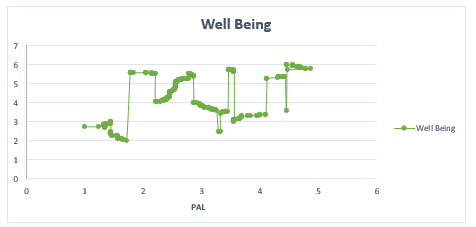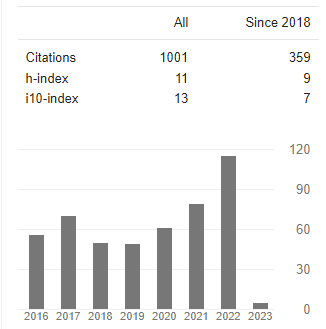Understanding the Association between Trait Emotional Intelligence and Physical Activity Levels in Female Adolescents
Abstract
Background: Participation in regular physical activity is influenced by several factors, including psychological aspects. However, the association between Trait emotional intelligence and physical activity levels remains relatively unexplored.
Aim: The aim of this research is to examine the association between the levels of physical activity and trait emotional intelligence.
Methods: A total of 240 female adolescent students took part in the study. TEIQue was utilized for assessing Trait EI and PAQ (A) for Physical Activity Levels. Spearman’s rho was applied to observe the association between the two variables.
Results: Significant positive correlations were found between physical activity levels and Global Trait Emotional Intelligence and its sub-variables viz. Well Being, Self-control, Sociability, and Emotionality.
Conclusions: There exists a significant but weak to moderate association between PA levels and Global Trait EI along with all its sub-variables
Downloads
References
Lee IM, Shiroma EJ, Lobelo F, Puska P, Blair SN, Katzmarzyk PT. Effect of physical inactivity on major non-communicable diseases worldwide: an analysis of burden of disease and life expectancy. Lancet 2012: 380: 219–229.
Cooney G, Dwan K, Mead G. Exercise for depression. JAMA 2014: 311: 2432–2433.
Stamp, Elizabeth and Crust, Lee and Swann, Christian (2015) Relationships between mental toughness, physical activity and barriers to exercise in undergraduate students. In: British Psychological Society Department of Sport and Exercise Science Conference, 14 - 15 December 2015, Leeds.
Kodama S, Tanaka S, Heianza Y, Fujihara K, Horikawa C, Shimano H, Saito K, Yamada N, Ohashi Y, Sone H. Association between physical activity and risk of all-cause mortality and cardiovascular disease in patients with diabetes: a metaanalysis. Diabetes Care 2013: 36: 471–479.
Soltanian AR, Nabipour I, Akhondzadeh S, Moeini B, Bahreini F, Barati M, et al. Association between physical activity and mental health among high-school adolescents in Boushehr province: A population based study. Iran JPsychiatry. 2011;6(3):112–6.
Fernández-Abascal E. G., Martín-Díaz M. D. Dimensions of emotional intelligence related to physical and mental health and to health behaviors. Front. Psychol. 2015: 6:317 10.3389/fpsyg.2015.00317.
Wu, Xiu Yun et al. ‚The Influence of Physical Activity, Sedentary Behavior on Health-Related Quality of Life among the General Population of Children and Adolescents: A Systematic Review.‛ Ed. Jacobus P. van Wouwe. PLoS ONE 12.11 (2017): e0187668. PMC. 2018: Web...
Jones MV. Emotion regulation and sport performance. The Oxford handbook of sport and performance psychology. New York, NY: Oxford University Press, 2012: 154–172.
Laborde S, Raab M, Dosseville F. Emotions and performance: valuable insights from the sports domain. In: Mohiyeddini C, Eysenck M, Bauer S, eds. Handbook of psychology of emotions: recent theoretical perspectives and novel empirical findings. New York, NY: Nova, 2013: 325–358
Goleman D. Emotional intelligence. New York, NY; England: Bantam Books, Inc, 1995.
Wang X. The role of anticipated negative emotions and past behavior in individuals’ physical activity intentions and behaviors. Psychol Sport Exerc 2011: 12: 300–305.
Scherer KR. What are emotions? And how can they be measured? Soc Sci Inform 2005: 44: 695–729.
Stough C, Saklofske DH, Parker JDA. Assessing emotional intelligence: theory, research, and applications. New York, NY: Springer Science, 2009: 85–101.
Laborde S, Dosseville F, Guillén F, Chávez E. Validity of the trait emotional intelligence questionnaire in sports and its links with performance satisfaction. Psychol Sport Exerc 2014a: 15: 481–490.
Solanki D, Lane AM. Relationships between exercise as a mood regulation strategy and trait emotional intelligence. Asian J Sports Med 2010: 1: 195–200.
Saklofske DH, Austin EJ, Galloway J, Davidson K. Individual difference correlates of health-related behaviours: preliminary evidence for links between emotional intelligence and coping. Pers Individ Dif 2007: 42: 491–502.
Tsaousis I, Nikolaou I. Exploring the relationship of emotional intelligence with physical and psychological health functioning. Stress Health 2005: 21: 77–86.
Magnini VP, Lee G, Kim B. The cascading affective consequences of exercise among hotel workers. Int J Contemp Hosp M 2011: 23: 624–643.
Li GSF, Lu FJH, Wang AHH. Exploring the relationships of physical activity, emotional intelligence and health in Taiwan college students. J Exerc Sci Fit 2009: 7: 55–63.
Singh, H. Exploring the relationship between trait emotional intelligence and physical activity levelss in male university students. European Journal of physical education and sport science 2018: 4 (3), 141-148.
Petrides, K.V. (2009). Psychometric Properties of the Trait Emotional Intelligence Questionnaire (TEIQue). In: Parker, J., Saklofske, D., Stough, C. (eds) Assessing Emotional Intelligence. The Springer Series on Human Exceptionality. Springer, Boston, MA. https://doi.org/10.1007/978-0-387-88370-0_5

Copyright (c) 2025 Harmandeep Singh, Amandeep Singh

This work is licensed under a Creative Commons Attribution 4.0 International License.














